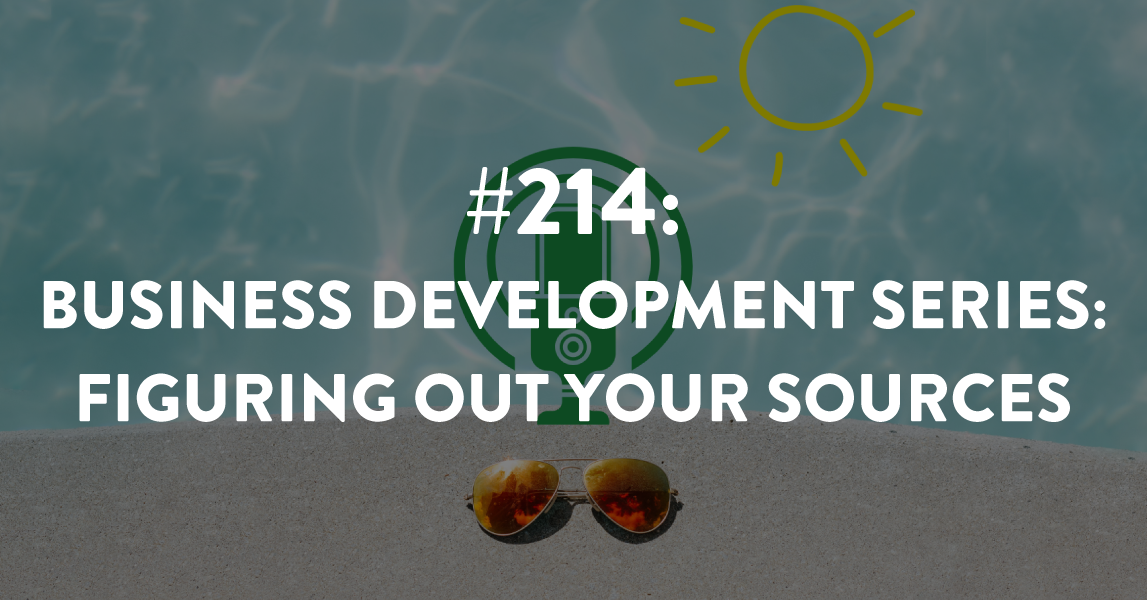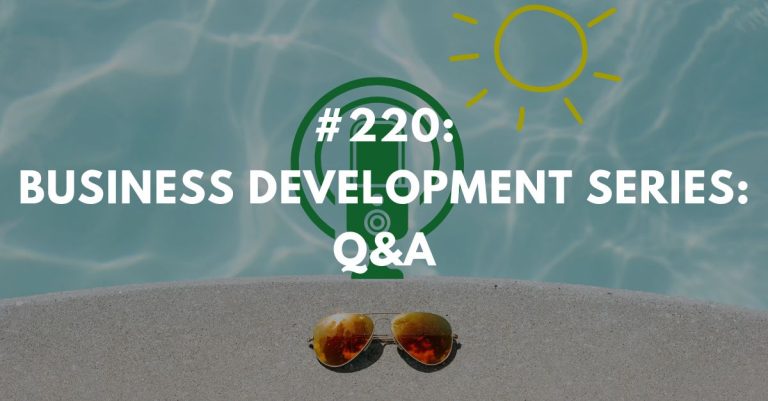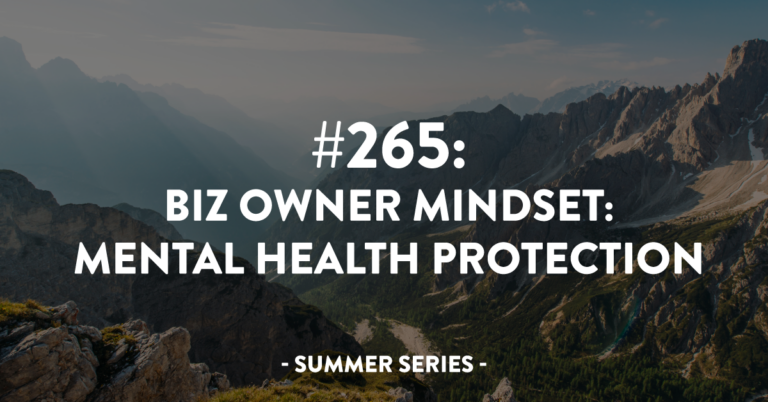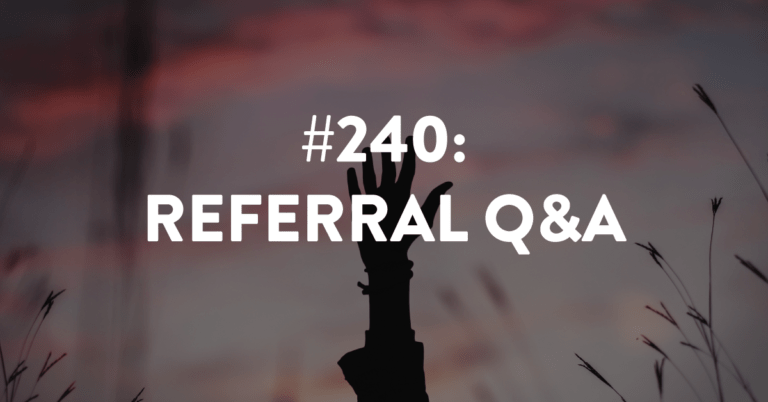Ep #214: Business Development Series – Figuring Out Your Sources
One of the key areas of business development is getting clients—but how do you get clients if you don’t know or understand where they come from? We will be digging in today to figure out the sources where your clients come from and how people learn about your business.
Knowing the data and stats on where your prospective new clients are coming from can be a complete game-changer for your business. Listen in to learn how to take a look at that data and dig in further to get a better understanding of how to move the needle forward using that information.
There will also be a sales strategy activity with a PDF that you can download to help walk you through this activity step by step. Be sure to use this to follow along so you can get the most out of this episode.
Download the Sales Strategy Activity PDF Now
Links Mentioned During the Episode:
- Where Referrals Fit in Your Sales Strategy Article
- Episode #011 & #012: Building Your Prospecting Plan
- Episode #038: Those First Two Years in Business
Looking for Referral & Client Experience Resources:
Take the Referral Ninja Quiz to test your skills and abilities at generating referrals. (FREE)
Buy my book – Generating Business Referrals Without Asking – and learn how to generate referrals through my 5 steps. (LESS THAN $16)
Consider joining Building a Referable Business™ – a unique way to learn all of my referral strategies and tactics with ongoing weekly access to me to answer your questions and help hold you accountable! Email me for more details.
Coming Up:
Next episode is #215, and we’re going to be talking about the buyer’s journey.
Download The Full Episode Transcript
Read the Transcript Below:
Stacey Brown Randall: Every client comes from somewhere. Yep, we know; they don’t just magically appear. And where they come from, it’s called a source. And knowing the sources that are producing for you in your business is very important. So, we’re going to dig into it today.
You are not just another hustling salesperson. You are the expert, the
resource, the valuable partner for your clients, and how you grow your
business should reflect how your clients see you.
Welcome to the Roadmap to Grow Your Business podcast. We generate
referrals without asking, build positive client experiences, and help
you take control of your business.
Here’s your charmingly sarcastic host, Stacey Brown Randall.
Stacey Brown Randall: Hey there, and welcome to episode 214 of the Roadmap To Grow Your Business Podcast. I’m your host, Stacey Brown Randall.
We are moving right along with our business development series and we are going to be digging in today to figuring out your sources, A.K.A. where your clients come from.
Or I guess I should say where your perspective clients come from, because before a client can be a client, well, they’re a prospect. And they become a prospect when they come through a source, which means how they learn about your business. And that source is a really important metric to how your business is doing.
So, there’s a couple of things I want to accomplish with this episode, and this part of our business development summer series. And that is first, understanding why it actually matters to know the hard, cold facts, the data behind where your perspective new clients are coming from.
Then after we talk about why it matters, we’re going to dig into just clarifying some terms, because I see these terms used interchangeably, and the truth is lots of people have lots of different definitions for what they mean. So, I’m going to give you my baseline definition so that the rest of this episode will make sense for you.
And then of course, I’m going to walk you through the exercise called the Sales Strategy Activity, to truly understand how to determine your sources. Now, to make this easier, there is actually a PDF that you can download that’ll walk you through step-by-step this activity.
So, I’m going to encourage you to fill this out because it actually will allow you just to complete the activity quicker. And that’s really important when we’re busy. And so, you’re going to download that PDF. You can grab that PDF on the show notes page for this episode, which is staceybrownrandall.com/214. That’s 214 for episode 214. And of course, you know it, Stacey has an E.
So, you can definitely download this PDF and then follow along with this episode, or listen to this episode, then go download the PDF, and then follow along with completing the activity within the PDF. It’s pretty self-explanatory if you were to just download this activity a little bit later, but definitely, helpful if you do it while you’re listening to this episode.
The other thing is there’s an article that goes deeper into the thoughts around this activity as well, and gives you a different take on the source conversation. And that is the article’s on my website, Where Referrals Fit in Your Sales Strategy. So, that article, Where Referrals Fit in Your Sales Strategy is also available on the article page of my website.
But the direct link for it is staceybrownrandall.com/fit. So, you can definitely go to the show notes page to access that article. Or of course, you can just type it into your browser right now, staceybrownrandall.com/fit.
And there’s a couple of episodes that I’ve also done in the past where I’ve tackled this concept of sources and understanding how to figure your sources out. If you go way, way, way, way, way, way back to the beginning of the podcast, we’re talking like within the first couple of months, episode 11 and 12 was a two-parter where we talked about prospecting.
Now, prospecting is just one piece of where your clients come from, but it’ll definitely help you dig in more on the prospecting side if you think you need that. And then of course, for this episode, we’re going to talk about all three areas of the sources that can be categorized in your business.
But episode 11 and 12 on this podcast will definitely give you the prospecting side of that. And then we talk about this a little bit more in episode 38.
So, each of those (the article and those three episodes) have a different take or a different slant to this same topic of figuring out your sources. This episode is going to give you kind of a totality look, kind of like a 30,000-foot view look at your sources, and then dig into the data and what the data reveals for your business.
So, first thing we got to do is talk about why this matters, because it always matters. Why we do anything should matter. And this one’s a biggie. Understanding where your perspective clients are coming from and where they’re coming from and how well that works in turning a prospect into a client is really important data for you to have your hands on.
It doesn’t mean that data doesn’t shift and change over time, of course, it does. But the reality of it is, is understanding how your business is getting more clients is just important data because number one, it helps you know you’re moving in the right direction.
And number two, it allows you to understand maybe where you need to double down because one particular source is working really well and if you put more time and energy, and maybe financial resources behind that, you could generate more clients.
The third reason, the other reason to really go through this process is because it also will tell you what’s not working. So, maybe where you need to pull back from or maybe eliminate something from what you’re doing now to generate clients. This will walk you through understanding maybe that’s not working for me the way I thought, and you’ll get really clear on what’s working and what’s not working
Which leads to better business decisions regarding what should I lean into or double down on, what should I pull back from. Or what is just doing great the way it is and it should maintain in maintenance mode.
Because there are different things you do whether you call them activities, you can call them levers in your business, it doesn’t matter. There are different things that you do that bring prospects into your business so that you can eventually get them to the point of them becoming a paying client and understanding what those are, and not in like, “Oh, well I do networking, I also belong to a leads group or two, and then I’ve got my website, and there’s some SEO happening in the background.”
Not the “These are kind of the things that I do,” but the, “Hey, these are the distinct things that I do on an ongoing basis that are actually producing clients or prospects first, before they can become clients into my business.”
I think anytime we can have the right, correct data at our fingertips, it just helps us as business owners make better decisions. But it’s also important to keep in mind your expectation of how a particular source or activity will work for you.
So, understanding what your website is supposed to do for you — it may be from an SEO perspective to bring prospects into your world via your website, but it also could just be a brand strategy as well, where you’re building your brand, building your reputation, and when people do find you, building that credibility factor.
So, there are things that we do that have objectives that are very clear in what we ultimately want them to produce. And so, understanding those objectives is important as well.
So, the why this matters; understanding your data of where your perspective clients are coming from is key to making better business decisions. Lean in, pull back, maintain — all decisions you can make when you understand what’s working and what’s not working when it comes to where your clients are coming from.
Let’s talk about some terms next. I definitely want to make sure we’re all on the same page. When I use words like “client” and “source” and “prospect” and “activity,” all these different things that I talk about, I want to make sure we’re on the same page.
And if you do download the PDF worksheet, the activity that goes along with this episode, the Sales Strategy Activity PDF — if you do download that on the first page, I actually break down all of these definitions for you because understanding these terms is important to making sure well, that we’re both talking the same language, and that you’re tracking with me based on how I’m expecting you to, based on my definition.
So, for me, you can’t read my mind, so I think it’s important that I just spend a few minutes talking with you about the different types of terms.
So, here’s the thing; the sales strategy is the overarching strategy of what you do to do sales. Whether you call it business development, like we’re calling this series, or it’s just straight up what it is: sales. Your sales strategy is like your overall plan, your overall strategy within your business to bring prospects into your business.
Now, I look at this as a three-legged stool; your sales strategy is a three-legged stool, and it includes the activities that you do in prospecting and marketing, but it also includes the plan and strategies you have in place for referrals.
So, again, “sales strategy” is just the big umbrella term for the things that you do; prospecting, marketing, and referral-based that are bringing clients or prospects (because they were a prospect before they were a client) into your business.
So, a prospect, that’s a potential client. Sometimes a prospect is also referred to a lead. Sometimes people use different definitions between prospect and lead. I use them pretty interchangeably.
A potential client is a prospect, which means they know about you. They’re considering investigating, or they are investigating what it would be like to hire you, but they have not decided yet to hire you. Of course, once they decide to hire you and they start paying you money, then they move from a prospect or a lead to a client.
Now, as I mentioned earlier, sources is A.K.A. where your clients come from. A source is the many different ways that a prospect finds you. So, it’s the different prospecting and marketing activities that you can do plus referrals.
So, let me first define activity and then I’m going to dig into prospecting and marketing, and then referrals. So, an activity is an action you take to bring a prospect into your business, and those activities can be prospecting in nature, marketing in nature, or of course, referral-based as well.
But they’re typically when you’re thinking about this from a prospecting or a marketing perspective, the activities that we’re doing that are prospecting or marketing in nature are typically individual activities you’re doing under an umbrella of prospecting and marketing.
In the referral world, though, it actually looks a little different. And of course, from that referral perspective, it is a strategy that we implement with different strategies based on where we are in business. Let me break that down a little bit more for you.
So, you understand overall, an activity is an action that you take to bring prospects into your business. Let’s look at prospecting activities because this bit is going to be really important for you to understand what you’re doing so you can actually complete the activity.
So, prospecting activities are typically short-term activities. An activity is ultimately a source. So, they are short-term activities that you take that you do to find prospects. Like it could be going to networking events. It could be cold-calling, it could be cold-emailing.
It could be joining a networking group that you are a part of on a monthly or weekly basis. It could be joining a leads group. It could be one-on-one networking that you do with folks like coffees and lunches. It could be buying leads. It could be attending trade shows.
Depending on your industry, this will look a little bit different. So, for example, for a real estate agent, a tactic that would fall under prospecting would be calling expired listings or calling for sale by owner homes.
Obviously, a financial advisor, an attorney would never do that because they don’t need to talk to somebody who used to have their house on the market and no longer has it on the market and it didn’t sell.
So, within your industry, obviously, there are additional specific things that you would do that would be prospecting in nature. But those kind of give you an idea of exactly what we’re looking at from a prospecting perspective. And I will run through those again, as I’m walking you through completing the activity.
Next, of course, are marketing activities. They’re more marketing in nature, a little bit longer term activities. We know that in some cases, we’re building that reputation of our business and that marketing side of it.
But it’s the things you do like advertising and publications or advertising and social media on social media platforms. It is public relations or earned media, getting some PR for your business. Of course, it is your website. It is SEO, which is called search engine optimization. So, it’s how people find you when they want to do a Google search.
It is speaking engagements. It can be social media marketing, which could just be the content that you’re producing or the post that you’re putting out there that send people to content on your website.
But it’s different from a paid ad. So, you have paid ads, and then of course, you can just have content that you’re putting out on social media as well, content marketing, et cetera.
So, there’s a number of different things you could be doing under prospecting and under marketing that are those activities. Well, those activities ultimately, become sources for how a prospect will learn about you and then decide “Maybe I want to do business with this person.”
And then of course, the third leg of that stool for the sales strategy perspective and the third type of activities — though, I’m using air quotes, you can’t see me doing — is the referral plan.
And it is different from standalone prospecting and marketing activities, because truly, you deciding to call expired listings as a real estate agent, or you deciding to run Facebook ads as an architect, those are standalone activities that you’re doing.
They all work together, hopefully, in concert with each other, the activities that you’re doing, but you do deploy them in a standalone fashion. The referral plan is a process you follow to receive referrals, whether it’s from people already referring you, and then of course, ultimately, from people that you want referring you.
So, your referral plan, being different from that standalone prospecting and marketing activities; the referral plan is a process to follow to receive referrals from people already referring you as a strategy in and of itself.
But then there are other strategies: developing new referral sources, having a referral client experience — there are other strategies that you do that help from a referral perspective.
So, again, those are definitions. We went from sales strategy, we explained prospect client, sources, activity, and then we dug into what are prospecting activities, marketing activities, and then what you’re doing from a referral plan perspective.
Now, let’s walk through the exercise so that you can complete it, so you can come back and listen to this as often as you need to. But that way, you can complete this activity.
So, really, the way I want you to think about this is step one of this activity is what we call the brain dump. It’s you listing out all the prospecting activities, marketing activities, and referral strategies that you are using to grow your business.
So, in the activity, there’s actually a giant wheel on the page and there’s all these spokes. Think about it like a bicycle. There’s all these like spokes in between that look like pie pieces. And you would actually just write in one activity per spoke.
Now, for some of you, you actually may need more than is there. And so, you may have to double up on your spokes. But for most of you, you’ll be able to say, “Okay, I belong to this networking group and maybe I belong to this leads group. And maybe I have a referral plan to get referrals from my existing referral sources.”
And maybe you can also say, “I do Facebook ads or I do social media posts three times a month” or whatever it is. So, you walk through each thing that you’re doing, you’re putting into the bucket, into an individual pie piece, an individual spoke in this wheel as all the things that you were doing as the activities that you’re doing to produce or generate new prospects, new potential clients into your business.
Use as many spokes as you need, and of course, if you have to double up and put two activities per spoke, that’s fine. Most of you will only need what’s there. And most of you will have blank spaces because maybe you don’t have the use for all of the spokes.
There isn’t a right or wrong here. I want you guys to understand that; whether it’s you have all your spokes are full, you have half empty spokes, you only have one spoke — okay, well, we don’t want just one spoke.
But no matter what you’re doing, there’s not a right or wrong here. This is just about what is. This is supposed to be an accurate reflection of what you’re doing now to bring in new clients. We can solve it later. But this is about what are you doing now?
Then, the second step on the third page, what you want to do, is you want to take that brain dump of activities. And there’s a chart that you want to be able to fill in to capture not only the activities that you’re doing, but the results of those efforts.
So, in this table, it walks you through, when you fill in the top line of an activity you’re doing, then it asks, okay, so how many new clients from that activity did you bring into your business in one year?
Now, you can decide to do this with a different timeframe. But the idea here is it’s the number of new clients in one year from that particular activity. Then it wants to know what’s the number of prospects from that activity in one year.
Let’s just say for sake of argument, you are doing … I don’t know, I’m going to use something generic Facebook ads. There may be lots of people who come through your Facebook ads and actually like download your free material … or we can use a networking event. Maybe that’s a little bit easier.
You can meet a lot of people at networking events and a number of people who want to have coffee with you that show an interest in your business, but they never actually move to the hiring you phase.
So, it’s how many prospects did this activity bring into your business in a year? And then of those prospects? Well, how many of those became clients? And understanding your clients, dividing with your prospects, gives you a closing ratio. And the activity, this chart walks you through how to do it and explains it.
So, you want to know, hey, this one activity I’m doing, like this networking group I belong to, I actually talked to 15 people last year from it and nine of them became clients. And then your closing ratio would be the number of new clients divided by the number of prospects.
So, for example, if I talked to 200 prospects, I don’t mean you like had a, “Hey, how are you doing?” I mean like, “Hey Stacey, tell me about your business, I think I may be interested.” If you talked to 200 prospects at networking events throughout a year, and you only close two of them into new clients, then the closing ratio would be 1%.
And then you can also write down how much time you spend doing that activity in a month. So, if you’re looking at this and you’re looking at this from a referral perspective — if you had referrals like existing referral sources, like you have existing referral sources and you’re taking care of them, the way that I teach it on a yearly basis; so, it’d be existing referral sources, and then it would be the number of new clients that came through referral. But then also, how many prospects were referred to you in all?
So, we know we got X number of prospects referred to us last year and of that, a certain number became clients. We would divide that up to get our closing ratio. I always want my clients to be above 50%, closer to 80% on their closing ratio with their referrals. There are obviously, things that go into that to make that a reality.
And then you would also say, “Well, how many hours a month do I spend following that referral strategy for my existing referral sources?” Well, the way I teach it, some months, it’s none. And some months, you have actually something to do, a touch point. So, overall, you could just average that out to be like two hours a month. It’s not actually two hours a month, but you could just average it out.
Because this way, you’re able to look at the activity, how many paying clients it brought to you, but how many prospects overall were brought into the business before they became clients; your closing ratio, and then the number of hours per month you spend on it.
If you go to 200 networking events a year and had 200 prospect conversations and closed two people — and that’s a 1% closing ratio. But if that’s taking you 15 to 20 hours a month, maybe we need to pay attention to how much time we’re spending in networking and the ROI from that. And is that something we need to pull back from a little bit versus where we need to be leaning into other strategies?
So, the idea of doing the brain dump into the wheel or the spokes, the pie pieces, that’s in step one in this process, and then digging into the actual data behind it, and the activity walks it through it guys. I mean, it gives you examples. It gives you ideas of what you’re going to do. It walks you through how to do it.
Completing this is probably going to be eye-opening as to where you spend the majority of your time versus which sources are actually producing paying clients. And then it asks you to do a step called Truth Time where you’re going to write down your top three to five best producing activities based on your closing ratio and the amount of time you’re spending on it.
And then it is going to ask you like how many clients in total did those top three to five activities produce for you in one year, and then how do you feel about your results. And your options are going to be, “Houston, we have a problem” or “Not horrible, but not great either.” And then “Fantastic.”
So, then, you get to assess what’s it looking like, how are you doing? But you’re also going to get to decide, “Hey, maybe, you know what? I have a really high closing ratio with my referrals. Maybe I need to lean into that to get more referrals because my closing ratio is higher and I spend less hours in a month on it.”
Obviously, that’s what I would want for you, but you have to go based on what your data shared with you. And then of course, it talks a little bit about what’s next after you do this activity.
But I just want you to do the activity and have an idea of what the heck is going on in your business from the perspective of where your prospects that are turning into paying clients, where are they coming from? Identifying your sources is such a key here.
So, in last week’s episode, we talked about the messaging, like the words that you use to convey how you help the people that you help, how you help your clients. So, messaging is so important so that someone can look at your information and say, “Yes, she gets me. He gets me, they understand my problem and yes, I want to work with them.”
So, that messaging is so important. Now, we need to understand the sources that we have in our business as well. And then coming up next week, of course, we’re going to talk in episode 215 about the buyer’s journey.
So, we’ve got our messaging piece, now, we know the sources of where our potential new clients are coming from. Well, before they get from a prospect to a client, there’s this thing called the buyer’s journey that they go through. And I’m going to give you an overview of that as well.
Remember, this is all things for our summer series that are business development related.
Remember, on the show notes page for this episode, staceybrownrandall.com/214, you can grab the PDF that’ll walk you through this Sales Strategy Activity. You can grab that PDF. You can download it from that page.
In addition, you can also find the link to the article that defines this a little bit more, goes in a little bit deeper kind of detail in Where Referrals Fit in Your Sales Strategy. That’s the name of the article on our articles page, and then a couple of other episodes as well, where we talk about this from a different perspective.
So, all of that good information will be there for you on the show notes page for this episode; episode 214. Again, the show notes page, staceybrownrandall.com/214.
As I mentioned, next week, we got episode 215. We’re talking about the buyer’s journey. Until then, take control and grow your business. Bye for now.
Thanks for listening to the Roadmap to Grow Your Business podcast. To
access all resources and links mentioned in today’s show, and to
connect with Stacey, head over to www.staceybrownrandall.com.







